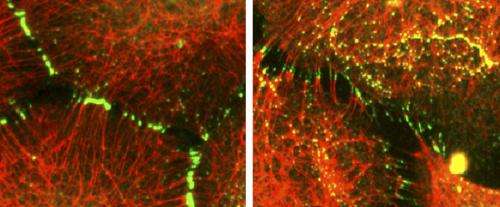Desmoplakin's tail gets the message

Cells control the adhesion protein desmoplakin by modifying the tail end of the protein, and this process goes awry in some patients with arrhythmogenic cardiomyopathy, according to a study in The Journal of Cell Biology.
Desmoplakin is a key component of the adhesive junctions, known as desmosomes, that link cells together in tissues that undergo severe strain, such as the heart and skin. Its role is to anchor parts of the cytoskeleton to sites of cell-to-cell contact. Kathleen Green and colleagues at Northwestern University Feinberg School of Medicine determined how modifying desmoplakin's intracellular tail with phosphate and methyl groups affects the protein's interaction with the cytoskeleton.
The enzyme GSK3 added phosphate groups to desmoplakin's tail, and its loss spurred the protein to shift from desmosomes to the intermediate filaments. Blocking GSK3 slowed desmoplakin's relocation from the intermediate filaments to the cells' boundaries during desmosome formation.
Methylation of four arginine residues in desmoplakin's tail had similar effects as phosphorylation. The team also found that methylation of one particular arginine, R2834, which is mutated in some patients with arrhythmogenic cardiomyopathy, was necessary for the phosphorylation of most tail serine residues because this modification drew GSK3 to desmoplakin. Mutating this arginine delayed desmoplakin's assembly into desmosomes, weakening intercellular connections so that cell layers broke apart under mechanical stress.
The results show that phosphorylation and methylation make desmoplakin more dynamic. Cells might be able to fine-tune desmoplakin's characteristics by adding and removing phosphates and methyl groups, and defects in this regulatory process might contribute to skin and heart diseases.
More information: Albrecht, L.V., et al. 2015. J. Cell Biol. DOI: 10.1083/jcb.201406020
Journal information: Journal of Cell Biology
Provided by Rockefeller University Press



















